Nagasaki
Understand
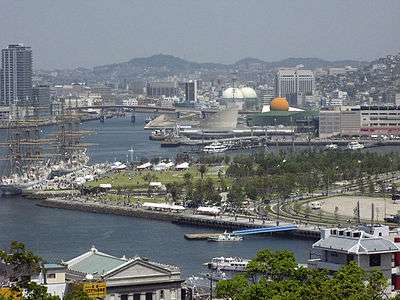
Under the national isolation policy of the Tokugawa shogunate, Nagasaki harbor was the only harbor to which entry of foreign ships was permitted. Even today, Nagasaki shows the influence of many cultures such as Dutch, Portuguese, and Chinese.
On 9 August 1945, three days after the bombing of Hiroshima, a nuclear bomb was dropped on Nagasaki, killing a total of over 100,000 people. Six days later Japan surrendered, ending World War II.
Get in
By plane
Both of Japan's major air carriers serve Nagasaki Airport. JAL and ANA offer nonstop flights from Haneda Airport in Tokyo and Osaka's Itami Airport. ANA also offers nonstops to Nagasaki from the new Nagoya Centrair Airport and Naha Airport in Okinawa, while JAL operates from Nagoya Airport in Komaki. In 2005, a new low-cost carrier, SNA (Skynet Asia Airways, now called Solaseed), began flights from Tokyo's Haneda Airport, providing cheaper tickets than major carriers. Another low-cost carrier, Peach Aviation, connects Nagasaki Airport with Osaka's Kansai International Airport at very low rates.
There are also nonstop international flights to Nagasaki from Shanghai (China Eastern Airlines) and Seoul (Korean Air), but these run much less frequently than the domestic flights.
Buses connect the airport to the Nagasaki train station (1 hour, ¥800).
By train

JR Kyushu runs the Kamome (かもめ) Limited Express train service from Hakata station in Fukuoka once or twice every hour. The one-way ride takes about two hours and costs ¥4,910, although it's recommended to buy nimai-kippu (discount two tickets) for ¥6,000 or yonmai-kippu (discount four tickets: recommended if two people travel) for ¥10,000 (¥5,000 for round-trip per person). If connecting via the Tokaido Shinkansen, you can instead opt for a Sakura train which reaches Shin-Tosu—switching to the Kamome from Shin-Tosu instead of Hakata can cut about 30 minutes off the trip. Fare for the Kamome is covered by the Japan Rail Pass.
If you intend to travel on the Kamome line from anywhere North of Nagasaki try to reserve a window seat on the left side of the train car on your way down to Nagasaki and on the right side on a trip departing from the city. This will ensure that you that get a close-up view of the fantastic scenery as the train runs right next to the Ariake Sea coast line.
Connections to the Kamome can be made from the rest of the country via the Shinkansen (Hiroshima, 3 hr; Okayama, 4 hr; Osaka, 4½ hr; Tokyo, 7 hr).
From Kagoshima-Chuo station in Kagoshima, Nagasaki can be reached via the Kyushu Shinkansen and Kamome in about 3 hr 45 min.
Sleeper Trains
You can travel overnight from Tokyo to Nagasaki, however you will have to take three trains: the 10PM Sunrise Seto/Sunrise Izumo overnight service to Okayama, the Shinkansen from Okayama to Hakata, and the Kamome from Hakata to Nagasaki. This will take a total of 13 hours, and if you're willing to constantly change trains, you will be rewarded as your journey will double as lodging.
Japan Rail Pass holders must pay the lodging charge on the Tokyo-Okayama segment; the rest of the trip is covered under the pass. An alternative if you want to make an overnight trip is to split up the trip into an evening leg and a morning leg, spending the night at a city along the way.
By bus
The Holland overnight bus runs from Kyoto and Osaka Umeda to Nagasaki (11½ hours from Kyoto, ¥11,300; 10 hours from Osaka, ¥11,000). An additional bus, the Roman Nagasaki, runs from Osaka Hankyu Bus Terminal to Nagasaki at the same cost and time.
The Princess Road and Etranger overnight buses run from Kobe Sannomiya (10 hours, ¥10,500) and Himeji (9 hours, ¥9,580).
Get around
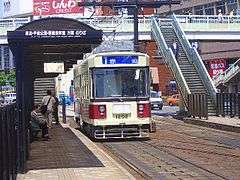
Trams (路面電車 romen densha or チンチン電車 "chin-chin densha") connect most of Nagasaki; they run about every ten to fifteen minutes during the day. The most frequently used lines will be the red (3) and blue (1); the blue and red lines run on the same track from the northern end of Nagasaki as far as the Nagasaki train station, where they split. The blue line continues to the You-me Plaza shopping mall, Dejima, and later the downtown shopping arcade. A one-way trip is ¥120 and you can get a transfer ticket (乗り継ぎ券 ”noritsugi ken") to continue your trip, if it requires two streetcars. These tickets can only be acquired if you get off at the Tsuki Machi stop. You can save money if you're doing a lot of travel by purchasing a daily pass for the streetcars (¥500) which you can purchase at the Tourist Information Center at Nagasaki Station, or most major hotels.
Buses also run through much of Nagasaki, including places that aren't served by the streetcars.
The street cars stop running around 11PM, and most bus service also has downtime at night. This can come as a rude awakening if you go out in Shianbashi, only to find that you have to stay until 6AM for the first running densha. For the adventurous, it takes about an hour to walk from Shianbashi to Sumiyoshi. This timeframe is heavily dependent on how fast you walk, and what kind of night out you experienced.
See
Nagasaki's tourism association coordinates a discount card for foreign tourists, applicable at many popular sites like Glover Garden, Dejima, and the ropeway to Mount Inasa. The card can be obtained from many hotels in the city. A multi-lingual call center can also answer tourism-related questions in English, Chinese, or Korean: +81-95-825-5175, 8AM-8PM 365 days a year. Save some paper by using their collection of electronic pamphlets (PDF) for several attractions.

- 🌍 Glover Garden (5 min by foot from tram stop Oura-tenshudo-shita of tram line 5 (destination 石橋 ishibashi)). 8AM-6PM. This is a pleasant collection of relocated European style homes built for foreign traders and diplomats when Japan was opened to world after the Meiji Restoration of the mid 19th century. It also offers a great view of Nagasaki harbor. ¥600.
- 🌍 Site of the Martyrdom of the 26 Saints of Japan. A monument and a museum stand on the site where 20 Japanese Christians and six European missionaries were crucified in 1597. These martyrs were canonized as saints in 1862. This site is also closest to Nagasaki Station; about 10 minutes on foot.
- 🌍 Inasayama (稲佐山) (take a bus from Nagasaki Station, or by streetcar to Takaramachi Station, or by bus or taxi to Fuchi Shrine Station). When the weather is clear, this mountaintop offers a full 360 degree view of Nagasaki City and harbor, and is a must-see site. The nighttime view of the city is called the "10 Million Dollar View" and ranked as one of the best 3 city night views in Japan. There is no entrance fee or hours, but there are limits on transportation there. Access is either by car, taxi, bus, ropeway, or a combination. The easiest is all the way up by car or taxi (for the former there's paid parking; for the latter it's about ¥2200 one way). Or there is a bus that goes up partway and requires a 15 minute walk up to the summit. This is the most economical and costs about ¥150 and about 15 minutes from Nagasaki Station (buses leave 1-2 times per hour). A third way is by ropeway between 9AM-8PM, and is ¥1200 round trip. To get to the ropeway station, walk five minutes from the Takaramachi street car stop, or take a bus or taxi to Fuchi Shrine Station and walk 2 minutes.
- 🌍 Koshibyo Confucius Shrine (a few minutes by foot from the streetcar No. 5 line's Ouratenshudo-shita stop). 8:30AM-5PM. This is the only Confucius shrine the Chinese built outside of China, and was constructed in 1893. It also has a large Chinese history museum behind it. It is often neglected and overlooked by many travel books and tourists, but has a gorgeous and bright appearance that is truly worth a visit. ¥525.
- 🌍 Sofuku-ji. 8AM-5PM. Constructed in 1629 by Chinese residents of Nagasaki, this temple is one of the best examples of Ming Dynasty architecture in the world. Even in China itself there are few surviving structures that display Ming Dynasty architecture as well as Sofuku-ji. ¥300.
- 🌍 Oura Catholic Church. Built in 1864 by French missionaries, it is the oldest remaining church in Japan. While not used as a church now, it still offers a look at 19th Century worship after Japan repealed its ban on Christianity. ¥300.
- 🌍 Urakami Cathedral. Rebuilt after its destruction in the atomic bombing, Urakami Cathedral was once the largest church in Asia.
- 🌍 Atomic Bomb Museum (5 minutes by foot from tram stop Hamaguchi-machi of tram line 1 or 3 (destination 赤迫 akasako)). 8:30AM-5:30PM. A well-done commemoration of one of the greatest tragedies of the 20th century. At the far end of the museum tour, you will find a powerful argument against nuclear proliferation, outlined in several well-designed exhibits. Buy yourself some ice cream after you leave - you'll need it. ¥200.
- 🌍 Dejima (Site of the Former Dutch Factory) (出島) (near Nagasaki Port Terminal, Dejima stop on the blue number 1 tram). 8AM-5PM - entrance closes at 4:40PM. Japan's sole port open to Western trade for over 200 years, Dejima Island was built to keep the West out-of-contact with the local populace in order to prevent the spread of Christianity. While only a few pieces of the original building foundations remain, the buildings have been recreated according to what we know about them, and you can walk inside their warehouses, quarters, kitchen, and other rooms. Dejima Wharf was built for commemorating the exchange between Japan and Netherlands for 400 years. There are 20 shops including restaurants. You can eat lunch or dinner watching the sea. ¥500.
- 🌍 Shinchi Chinatown (a few minutes walk south of Tsukimachi street car station), fax: +81 95-822-6540. From the 15th to the 19th centuries Chinese traders and sailors called this area home and it is the oldest Chinatown in Japan. Four narrow streets come together to a central intersection, with several restaurants and shops contributing their part to Nagasaki's unique character.
- 🌍 Nagasaki Penguin Aquarium. A surprisingly entertaining and informative aquarium located about 30 min [by bus] from Nagasaki station. A 12-m deep tank dominates the entry way. You can observe a variety of penguins from the vantage of underwater. A number of other aquaria contain many species of fish and invertebrates found locally, as well as a huge tank containing giant catfish (pla bluk) from the Mekong River in Thailand. The building is adjacent to a delightful sandy beach that could make a day with kids full and exciting. ¥500, kids under 3 free.
- 🌍 Suwa Shrine, 18-15 Kaminishiyama-machi (5-minute walk from Suwa-Jinja-mae Station on the Nagasaki Electric Tramway), ☎ +81 95-824-0445. The primary site of Nagasaki's annual Kunchi festival, the shrine's expansive grounds situated on the Tamazono mountainside offer a panoramic view of the city, amusing lion-dog guardian statues, and ceiling paintings by 75 artists. Free.
- 🌍 Kofuku-ji (about 8 minutes on foot from the Kokaido-mae streetcar stop), ☎ +81 95-822-1076, fax: +81 95-827-2726, e-mail: kofukuji@bg.mbn.or.jp. 8AM-5PM. This was the first Obaku Zen temple in Japan, established around 1620, and Nagasaki residents often call it the "red temple". It was used by many Chinese for over 3 centuries, and is one of the few historical places to escape damage from the atomic bombing. ¥300.
- 🌍 Oka Masaharu Memorial Nagasaki Peace Museum (岡まさはる記念長崎平和資料館). Tu-Su 9AM-5PM. One of the few places in Japan where the war crimes of the Japanese army during the Second World War are documented. Another focus of the exhibition lies on the foreign victims of the atomic bomb and their struggle for recognition and compensation. The Museum is located close to the central train station and just next to the memorial for the "26 Saints of Japan". No English explanation (just a few paragraphs on a leaflet at the entrance). ¥250, ¥150 for under 16 year old.
- 🌍 Nagasaki Museum of History and Culture. 8:30AM-7PM. ¥600.
- 🌍 Nagasaki Prefectural Art Museum. 10AM-8PM. Beautiful new building (featured in Architecture Week) that often has touring exhibits from around the world. Fees are required for temporary exhibits. Free-¥400.
- 🌍 Fukusai-ji, 2-56 Chikugo-machi. 8AM-4PM. An Ōbaku Zen temple in Nagasaki, Nagasaki, Japan. Its honorary sangō prefix is Bunshizan (分紫山?). Founded in 1628 and destroyed in 1945, Fukusai-ji has since been reconstructed in the shape of a turtle with an 18-metre high aluminium alloy statue of Kannon, the Bodhisattva of compassion. The interior is famous for the 25-metre Foucault Pendulum which swings over the remains of 16,500 Japanese killed during World War II. ¥200.
Do
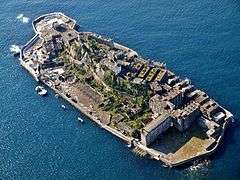
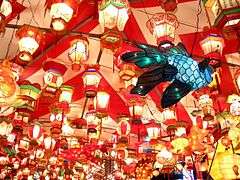
- 🌍 Gunkanjima (Hashima), Tokiwa Terminal, 長崎県長崎市常盤町1-60常盤ターミナルビル102号 (Take number 5 (green) tram toward Ishibashi to Ourakaigan-Dori stop, walk 1 minute toward the water), ☎ +81 95-8959300, e-mail: reservation@gunkanjima-concierge.com. 9AM-6PM. Gunkanjima (lit. "Battleship Island") is a small island completely covered in the ruins of a mining city, abandoned since 1974. Once the most densely populated place on earth, it's now a ghost town, showing the decay of what society leaves behind. Gunkanjima is about 15 km away from Nagasaki and is reachable as a part of organized boat tours since 2009. It takes its name from actually looking like a battleship from a distance. The tour includes a brief video presentation prior to embarkation, and a guided walk on the island. Explanations are in Japanese and headsets are available (free of charge) with an English recording. Upon return, the boat will circle allowing passengers sitting on either side to take photos. The full tour takes about 170 minutes and starts twice daily, at 10:10AM and 1:30PM. It can be booked and paid in advance online, or on-site up to an hour beforehand. Be aware that due to the precarious nature of the Gunkanjima dock, these tours are cancelled frequently for bad weather. For those of you thinking of jumping the fence and having a free saunter, think again, as all patrons are not only forced to sign a very specific no-fence-jumping waiver, but have to wear the same list of said rules around their necks at all times. There is a memorial to the many Korean workers who lost their lives to the mines of this island as a result of the forced labor programs during Japan's occupation of Korea. This was a dramatic film location for the James Bond film Skyfall. ¥3900 (weekday adult; add ¥300 on weekends, discounts for children).
- Lantern Festival Lunar New Year (mid Jan-mid Feb). Held by Nagasaki's Chinese community, large lanterns are displayed on street corners and in the shopping arcades. Venture through Chinatown or along the river in the evening to see some of the more than 20,000 lanterns displayed in the city. Many of the lanterns are shaped like animals or figures from Chinese mythology, and the major lantern every year represents the corresponding zodiac animal (e.g., 2008 featured rats, 2007 featured pigs, etc.)
- O-Kunchi, the city's biggest and one of Japan's more popular festivals, takes place October 7-9th annually. This festival, based around the descent of the city's patron kami(神)from their home high up in the Suwa Shrine, features choreographed routines with giant, cumbersome floats, sake, and a general feeling of celebration. Finding food will not be a problem during O-Kunchi, as the streets are lined with thousands of vendors hawking takoyaki, yakitori, and grilled corn on the cob.
- Although all of Japan celebrates O-Bon in August, Nagasaki puts a unique and deafening spin on the day of ancestor worship. Head down to the harbor for the main festivities, which involve far more alcohol and fireworks than is generally considered safe.
- A quick boat ride to Iojima is the easiest way to get to a beach. From Nagasaki harbor to Iojima is about ¥1500 and about 10-15 minute another ¥500 gets you in. The boat ticket allows a visit to the hot springs in the hotel on Iojima so that visitors can wash up.
- A quick jaunt into Shianbashi, or Shianbash for short, is a must when you visit Nagasaki. This area of Nagasaki exudes debauchery, full of numerous Snacks (not to be confused with a snack bar) and drinking establishments.
- If you are in Nagasaki between March and June, you can take a walk with Saruku-Chan. More commonly known as Saruku-Haku, these guided tours allow the Sarukist to experience the history of Nagasaki in a very unique way, by walking it! Available with orators teaching in either Japanese and English, these walks are quite the learning experience. They require a bit of multitasking: one must be able to listen, walk and look at the same time. The course sizes range from just a few miles to a monstrous 13 mile jaunt.
Buy
- 🌍 Youme Saito, 10-1 Motofunamachi, ☎ +81 95-823-3131. Located next to Dejima Wharf in downtown Nagasaki, this multistory shopping plaza offers a range of stores and services, including a Starbucks, travel agent, a grocery store in the basement, and of course, a grand selection of clothing stores. The grocery store in particular has a good selection of foreign imports and cheese compared to other supermarkets. The Kinokuniya bookstore on the fourth floor carries a small selection of English-language books. Next to Kinokuniya is also a food court with multiple selections. Youme Saito is easily accessed by taking the blue streetcar line to the Ohato stop.
- 🌍 Nishi-Hamanomachi. Also from the blue line, you can access this enormous covered arcade from up to four streetcar stops, the easiest of which are the ones marked "Hamanomachi." There is a proliferation of restaurants, coffee shops, clothing stores, hair salons, and multi-level electronics stores.
- 🌍 Chitosepia, 5-1 Chitosemachi, ☎ +81 95-842-6001. At the Chitose-machi tram stop, with several clothes stores on the second and first floor as well as an arcade on the second floor. This can be a good place to start shopping. Several restaurants are in the basement as well as a grocery store. The restaurants include Japanese food, a curry restaurant and an Italian restaurant. One recommendation for a cheap and tasty pick-me-up snack is the Hearth Brown patisserie on the lower level Also one of the restaurants here serves Turkish rice (toruko-raisu).
- 🌍 Seiyu, 1-6-10 Hayama, ☎ +81 95-857-1155. Beyond the reach of the Nagasaki trams, so take a bus, is the shopping center of Seiyu. With a Haagen-Dazs ice cream shop and a McDonald's in front it is hard to miss. With almost anything anyone could want, from book store to clothing stores to electronic stores, Seiyu has it all, though in a slightly inconvenient place.
- 🌍 AMU Plaza. At the Nagasaki station tram stop is Amyu (AMU) Plaza and with a multitude of stores to see in the plaza and several stores around the plaza that might interest people, including a book shop and an arcade. The bookstore contains a small but serviceable selection of English-language books as well. Inside the plaza is 3 stories of shopping extravaganza, there are clothes, books and electronic stores all around. There are several restaurants on the bottom and top floors of the building as well as an area for people to buy Nagasaki related knick-knacks and souvenirs. There is also an import store called Dragon Deli on the bottom floor where one can find soda that isn't readily available in the rest of Nagasaki, like Dr. Pepper and A&W Cream Soda. Amu Plaza is more expensive than YouMe Saito.
Eat
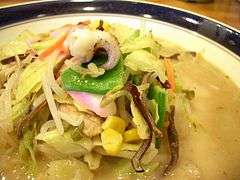
Nagasaki's most famous dish is champon (ちゃんぽん), which is a hearty dish of noodles in a pork-based broth, filled with vegetables, bacon, shrimp, squid, and scallops.
Saraudon (皿うどん) is another popular dish that combines the meat, seafood, vegetables, and sauce of champon, but serves it on a plate, or 'sara', over crispy dry fried noodles.
For Nagasaki's most well-known champon and saraudon restaurants, it is best to head into Chinatown (blue streetcar to the Tsuki-machi stop). While you're there, try out some of the fantastic street food, such as kakuni-manju (marinated braised pork cutlet served in a steamed bun), ebichiriman (shrimp fried in chili sauce, again served in a steamed bun), and marakao (steamed pound cake, usually available in chocolate and chestnut flavors).
Castella (カステラ) is a sponge cake that was originally brought by the Portuguese; it has assumed a distinctly light Japanese flavor and texture over the centuries, and now one can find it in flavors such as honey, chestnut, and green tea. Head to the Dutch Slope (オランダ坂) on any day of the week to sample castella for free from one of the many vendors.
Chawan mushi, a steamed egg custard, savory instead of sweet and filled with meat, fish, and mushrooms, is also famous.
Another Nagasaki dish is Turkish Rice (トルコライス toruko raisu), named after the country. It consists of a pork cutlet, dry curry mixed into rice, and a small serving of spaghetti, all on the same plate. Tsuru-chan (ツル茶ん), Aburayamachi 2-47, tel. +81 95-824-2679. Established in 1925, this is the original and perhaps still the best Turkish Rice joint (¥850 a serve) and one of Japan's first cafes. Open 9AM to 10PM every day.
Drink
The worthwhile trip to the top of Glover Garden also yields another point of interest: the oldest Western-style restaurant in Japan, the Tenjin Coffeehouse. The stop in is worth it to see their impressive Dutch coffee-making equipment, when combined with the historicity could be why they charge about ¥550 for a cup.
Sleep
Budget
Being a large city, Nagasaki offers the full range of "alternative" sleeping arrangements.
- The cheap Planet Manga/Internet Cafe can be found two doors down from the Toyoko Inn on the main street south of the Nagasaki train station (about 3-4 min. walk from Nagasaki JR station). A 9-hour night pack will set you back ¥1780, and a 12-hour ¥1980 (it should cost an additional ¥300 for the membership fee, but if they see you won't likely come back again they may, just may, waive the fee). They have quite comfortable private booths where you can sleep fine on a mat if you're less than 190 cm tall. Even if they have a non-smokers' section, partitions are not far away. As all manga cafés in Japan, there's a soft drink bar.
If not on that much of a budget, consider one of Nagasaki's many youth hostels:
- 🌍 Nagasaki International Hostel AKARI, 2-2 Kojiyamachi, Nagasaki-city 850-0871 (3 minutes walk from Kokaido-mae Station on number 3 (red) tram), ☎ +81-95-801-7900, e-mail: akari@nagasaki-hostel.com. Check-in: 3PM-8PM, check-out: 11AM. A comfortable hostel in center of the city. Friendly staff are willing to help guests making travel plans. Free wireless Internet in rooms and three computers in the lobby. Has a program called “Short walk with Nagasaki Locals”. Hostel operates a cafe near Nagasaki Station where you can leave luggage after checking out. Dormitory ¥2600, Ladies Dormitory ¥2900, private rooms starting at ¥6600. Rates slightly higher in winter.
- 🌍 Casa Noda, 6-1 Motofuna-machi, Nagasaki city 850-0035 (5-minute walk from Nagasaki Station, 1 minute from Goto Machi tram stop), ☎ +81-95-800-2484, e-mail: info@casanoda.jp. Check-in: 2PM-8PM, check-out: 10AM. The owner is nice and gives very good tips about the local restaurants and temple area. Good English is spoken. Use the map on their website to find it. Dormitory ¥2400, mixed or female-only. Private twin rooms ≈¥6000. Breakfast included, cash only.
- 🌍 Nagasaki Kagamiya, 1-12-9 Honkouchi, Nagasaki-city 850-0012 (5-minute walk from Hotarujaya stop on the No. 3 (red) tram), ☎ +81-95-895-8250, fax: +81-95-895-8251, e-mail: info@n-kagamiya.com. Check-in: 3PM-8PM, check-out: 11AM. Air conditioning, wifi, laundry available, shared fridge but no kitchen. Photos on the web site provide detail on how to find the location. Mixed dormitory ¥2300 (Western or Japanese style), Japanese-style private starting at ¥2800 per person. Cash only.
- 🌍 Casa Blanca Guesthouse, 7-16 Dōzamachi Nagasaki-shi, Nagasaki-ken 850-0841 (See website.), ☎ +81 95-807-322, e-mail: info@cb716.jp. Check-in: 2PM-9PM, check-out: 10AM. Nice guest house in a nice place of the city. Near China town. Cash only. English is spoken. ¥2600.
Mid-range
The typical array of business hotels can be found situated a short walk south of Nagasaki train station, along the main road between the station and the ferry terminal. The Toyoko Inn Nagasaki does not offer the usual post-midnight check-in discount.
- 🌍 Victoria Inn Nagasaki, 6-24 Dozamachi, Nagasaki 850-0841 (1-minute walk from Kanko-Dori stop on the No. 1 (blue) tram), ☎ +81-95-828-1234. Check-in: 1PM, check-out: 11AM. Very centrally-located, a few minutes' walk from Shianbashi, the shopping arcades, Shinchi Chinatown, and the central Tsuki-Machi tram stop. Spacious rooms, including huge luxury Victorian-styled rooms available on upper floors. Elegant old-world styled bar that is worth a visit even if you don't stay at the hotel, open late and happy hour specials. Organic restaurant that serves guest breakfasts. Double ≈ ¥6500-7000.
- 🌍 Richmond Hotel, 6-38 Motoshikkuimachi (1-minute walk from Shianbashi stop on the No. 1 (blue) tram), ☎ +81-95-832-2525, fax: +81-95-832-2526. Check-in: 2PM, check-out: 11AM. An upmarket business hotel with very modern finishings, in the heart of Shianbashi—if you want to exploit the nightlife to its fullest and not worry about tram service ending, this is your place. Excellent English-speaking staff can assist with tourism inquiries. Double ≈ ¥7000.
- 🌍 Minato Sauna. A sauna/sento (bathhouse) and capsule hotel located two blocks east of Nagasaki ferry terminal. Look for the jolly sailor logo on the and note that despite the clearly arrowed signage, the entrance is actually in the alley to the left. Sauna-only prices vary by time, but the full overnight stay costs ¥3675. Although mid-range in capsule hotel pricing, the facilities are top-notch with completely smoke free sleeping quarters, sauna entry and re-entry included, free phone charging facilities and none of the common surprise towel, yukata or otherwise dodgy surcharges. An affordable restaurant and bar are on site as is a coin laundry so you can even wash the pants you are wearing. Men only.
- 🌍 JR Kyushu Hotel Nagasaki (just up the escalator from the station gates). Good value business hotel owned by JR - incredibly convenient as it's in the station complex. ¥7,600+.
Splurge
The luxury rooms of Victoria Inn, above, would be suitable for special occasions.
- 🌍 ANA Crowne Plaza Nagasaki Gloverhill, 1-18 Minamiyamate-Machi Nagasaki Nagasaki, 42 850-0931 Japan (street car station Ouratenshudoshita), ☎ +81 95-818-6601. Check-in: 2PM, check-out: noon. Four-star hotel close to the international cruise ship terminal, Glover Hill and most sights in the old part of Nagasaki. Its convention center is popular, too. Most guests are business traveler or package tourists. Breakfast is good but expect crowds in the morning.
Go next
- Nagasaki Bio Park: This is a little ways outside of the city, but it is definitely worth an afternoon. This is perhaps the world's largest and best petting zoo, where one can feed and pet animals like capybara, flamingos, mara, and wallabies. From Nagasaki Station (長崎駅), hop on the Ogushi (大串) bus line, and ride north until you reach Kamedake (亀岳). Follow the signs with the cute animals, and Biopark will be on the right approximately 500 meters down the road. To return, look for the Nagasaki Terminal (長崎ターミナル) buses, which usually run hourly until 9.
- Huis Ten Bosch: This is a Dutch-themed park in nearby Sasebo, which one can access with the Kamome train line. For those who have already toured the Netherlands, there is probably not much of a draw, but if you are interested in the uncanny Japanese ability to faithfully reproduce the works of other countries (they even imported the bricks from the Netherlands), it is worth a visit. There is a free shuttle service available from Huis Ten Bosch to Nagasaki Bio Park.
| Routes through Nagasaki |
| Saga ← Tara ← | N |
→ END |
| Tosu ← Ureshino ← | N |
→ END |